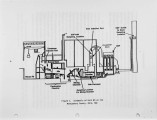| Title |
Assessment of Trace Organic Emissions Test Results from the Montgomery Count South MWC in Dayton, Ohio |
| Creator |
Lanier, W. Steven; von Alten, T. Robert; Kilgroe, James D. |
| Publisher |
University of Utah |
| Date |
1990 |
| Spatial Coverage |
presented at San Francisco, California |
| Abstract |
This paper provides an evaluation of the formation and removal of polychlorinated dibenzo-p-dioxins and polychlorinated dibenzofurans (CDD/CDF) at various locations throughout the Montgomery County South municipal waste incinerator in Dayton, Ohio. The Montgomery County facility is a mass burn refractory incinerator which consists of an ignition chamber, rotary kiln, mixing chamber, conditioning (quench) chamber, electrostatic precipitator (ESP), and stack. Three tests at each of six different test conditions were conducted to evaluate the effects of ESP inlet temperature, sorbent injection, and combustion temperature on pollutant formation and emission. The test results indicated two sources of CDD/CDF formation: the combustor upstream of the mixing chamber and the ESP. Based on an analysis of CDD/CDF concentration reductions across the mixing chamber it is postulated that CDD/CDF leaving the combustor was associated predominantly with entrained particulate matter (PM) with particle sizes greater than 10 J.l.m. Indicated CDD/CDF formation rates within the ESP were highly dependent on ESP inlet temperature. In tests without sorbent addition (no acid gas control), reducing average ESP inlet temperatures from 571 to 397°F (299 to 203°C) reduced average stack emission of CDD/CDF from 17,100 to 870 ng/dscm at 7% 02. Three tests at poor combustion conditions (low mixing chamber temperature) produced concentrations of CDD/CDF at the ESP inlet and stack that were similar to those produced by comparable good combustion tests. However, the concentration of CDD/CDF in collected fly ash from the poor combustion tests was nearly double that from comparable good combustion tests. Furnace injection of limestone at an ESP inlet temperature of 391°F (199°C) resulted in a moderate increase in average CDD/CDF emission of 1480 ng/dscm as compared with 870 ng/dscm during tests at an ESP inlet temperature of 397°F (203°C) without sorbent injection. This is believed to be due to lower ESP performance during limestone injection tests. Furnace sorbent injection tests of limestone at an ESP inlet temperature of 298°F (148°C) resulted in average stack emissions of 670 ng/dscm. Tests with duct injection of hydrated lime at 306°F (152°C) ESP inlet temperature provided the best results with average CDD/CDF emissions of 57 ng/dscm. The work presented in this paper was supported by funding from the U.S. Environmental Protection Agency, Air and Energy Engineering Research Laboratory and the Office of Air Quality Planning and Standards. |
| Type |
Text |
| Format |
application/pdf |
| Language |
eng |
| Rights |
This material may be protected by copyright. Permission required for use in any form. For further information please contact the American Flame Research Committee. |
| Conversion Specifications |
Original scanned with Canon EOS-1Ds Mark II, 16.7 megapixel digital camera and saved as 400 ppi uncompressed TIFF, 16 bit depth. |
| Scanning Technician |
Cliodhna Davis |
| ARK |
ark:/87278/s6h997rf |
| Setname |
uu_afrc |
| ID |
6163 |
| Reference URL |
https://collections.lib.utah.edu/ark:/87278/s6h997rf |



















